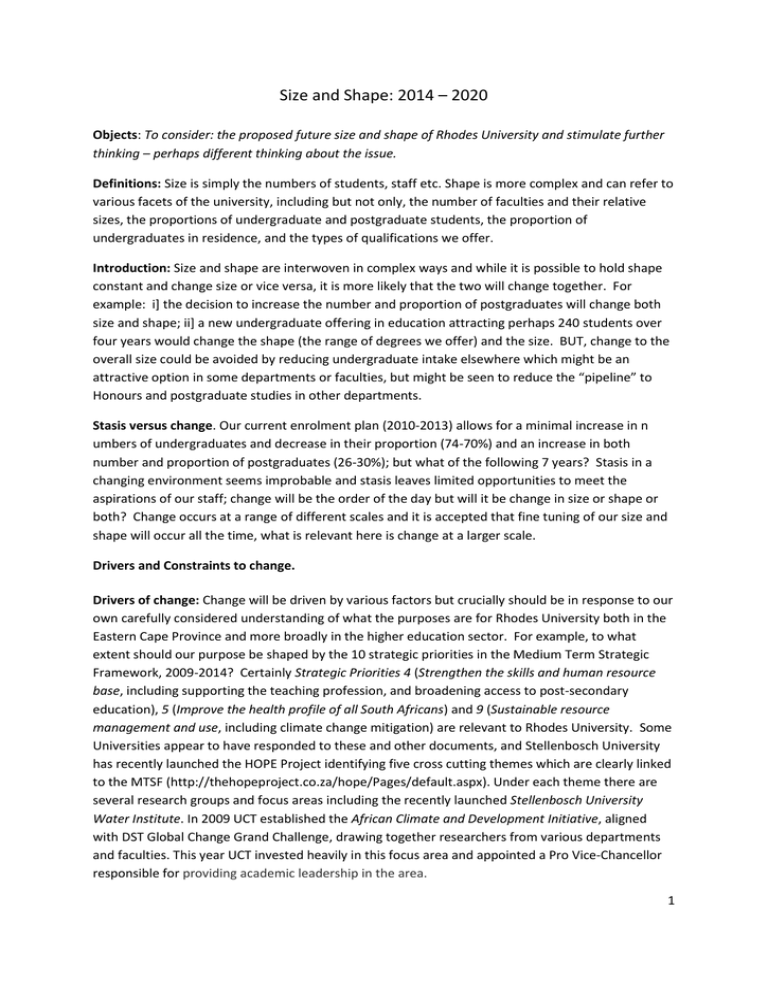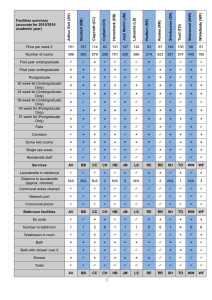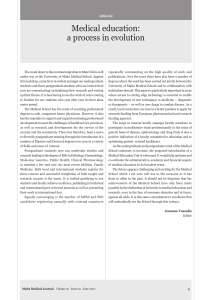Size and Shape - Rhodes University
advertisement

Size and Shape: 2014 – 2020 Objects: To consider: the proposed future size and shape of Rhodes University and stimulate further thinking – perhaps different thinking about the issue. Definitions: Size is simply the numbers of students, staff etc. Shape is more complex and can refer to various facets of the university, including but not only, the number of faculties and their relative sizes, the proportions of undergraduate and postgraduate students, the proportion of undergraduates in residence, and the types of qualifications we offer. Introduction: Size and shape are interwoven in complex ways and while it is possible to hold shape constant and change size or vice versa, it is more likely that the two will change together. For example: i] the decision to increase the number and proportion of postgraduates will change both size and shape; ii] a new undergraduate offering in education attracting perhaps 240 students over four years would change the shape (the range of degrees we offer) and the size. BUT, change to the overall size could be avoided by reducing undergraduate intake elsewhere which might be an attractive option in some departments or faculties, but might be seen to reduce the “pipeline” to Honours and postgraduate studies in other departments. Stasis versus change. Our current enrolment plan (2010-2013) allows for a minimal increase in n umbers of undergraduates and decrease in their proportion (74-70%) and an increase in both number and proportion of postgraduates (26-30%); but what of the following 7 years? Stasis in a changing environment seems improbable and stasis leaves limited opportunities to meet the aspirations of our staff; change will be the order of the day but will it be change in size or shape or both? Change occurs at a range of different scales and it is accepted that fine tuning of our size and shape will occur all the time, what is relevant here is change at a larger scale. Drivers and Constraints to change. Drivers of change: Change will be driven by various factors but crucially should be in response to our own carefully considered understanding of what the purposes are for Rhodes University both in the Eastern Cape Province and more broadly in the higher education sector. For example, to what extent should our purpose be shaped by the 10 strategic priorities in the Medium Term Strategic Framework, 2009-2014? Certainly Strategic Priorities 4 (Strengthen the skills and human resource base, including supporting the teaching profession, and broadening access to post-secondary education), 5 (Improve the health profile of all South Africans) and 9 (Sustainable resource management and use, including climate change mitigation) are relevant to Rhodes University. Some Universities appear to have responded to these and other documents, and Stellenbosch University has recently launched the HOPE Project identifying five cross cutting themes which are clearly linked to the MTSF (http://thehopeproject.co.za/hope/Pages/default.aspx). Under each theme there are several research groups and focus areas including the recently launched Stellenbosch University Water Institute. In 2009 UCT established the African Climate and Development Initiative, aligned with DST Global Change Grand Challenge, drawing together researchers from various departments and faculties. This year UCT invested heavily in this focus area and appointed a Pro Vice-Chancellor responsible for providing academic leadership in the area. 1 Change may also be driven through the creation of opportunities. Funds from Mellon have allowed the development of research focus areas in the humanities; the Sandisa Imbewu Fund has created an opportunity to dream more ambitious projects; the infrastructure funding from the DHET creates opportunities that otherwise do not exist. Change will be driven by the academic visionaries who can make the best of these opportunities. The context within which we function serves both as a driver and constraint for change. For example, our rural location may drive change (perhaps justify the development of rural development or agrarian reform as a cross cutting theme), but our location may in other ways act as a barrier to change. Constraints: Constraints to change are varied and include Physical (beyond our control) such as the size of the City and its infrastructure; Historical/Physical (within our control to some extent) such as the location of departments in inappropriate buildings where there is no further room for growth; The pool of available school leavers – In the Science Faculty, we offer places to all suitably qualified applicants, if we were to increase undergraduate intake it is likely that we would have to accept more students with lower points and this would have multiple implications; Financial constraints: our budget is limited and the wage bill is close to 70% (but see below under drivers of change); Value driven constraints such as a preferred staff: student ratio, a preference for a wide range of subject combinations in the undergraduate curricula, preference for a particular style of teaching, a green campus, a view that all first year undergraduate students should have a place in the residence system, and many others. A tool for understanding our ability to change in Size: To understand our ability to increase in size, we need to understand how our size relates to our “capacity to cope”. In this context, “capacity to cope” refers to everything from staffing and academic infrastructure to residences and dining halls, alternatively, capacity to cope could be seen as the maximum size of the University given its present infrastructure and staffing. Figure 1 illustrates this idea and shows two theoretical scenarios. In Figure 1, the green line represents a growing student population. Each step in the red and blue lines represents an increase in capacity resulting, for example, from an increase in staff numbers or a new building. The size of the steps will vary and will be big for events that increase capacity greatly (i.e. a new building), and much smaller for events that bring about a smaller increase in capacity (i.e. the appointment of a new staff member). The blue line represents the situation with residences where we are always playing catch up (new residences are full the day they are commissioned) and the red line is the opposite where we try to plan ahead. While it may be possible for the provision of residences to lag behind (there are always beds available in town) this is not the case for lecture venues or teaching staff. Once lecture venues are filled to capacity and staff are fully occupied with teaching (i.e. where red and green lines touch) it becomes essential to invest in additional staff or buildings (OR explore different, more efficient, ways of using the staff and space). Thus, understanding how our present size relates to our “capacity to cope” is important. If we are under capacity, then growth in student numbers can be achieved at little additional cost (financial & educational quality); if we are at capacity then further growth requires substantial financial input or a paradigm shift in the way we do things. 2 6500 6500 6000 6000 5500 5500 5000 5000 4500 4500 4000 4000 3500 3500 3000 3000 2500 Capacity Student numbers (2.5% growth rate) Figure 1. A theoretical representation of the relationship between growth in student numbers (green line) and a measure of “capacity to cope” (red and blue lines). 2500 0 5 10 15 20 25 30 Time (years) How close are we to where the red and green lines intersect? This will vary depending on what is being considered (capacity in lecture venues or laboratories, supervisory capacity, space in residences) and will vary between academic departments. While it is a difficult question to answer, we need to have a good understanding of how fully we utilise our venues and how close to capacity our staff are in order to gauge whether we can support further growth. Growth at the undergraduate level Infrastructure: Currently, our lecture theatres are well, but not fully utilised (see report at http://www.scifac.ru.ac.za/misc/venueproblems/report12009.htm for a complete discussion of this) with some unused periods in some slots in most venues. In 2009, the 11 largest lecture venues with a capacity of 120 or more were booked for 82% of the week (7.5 of the 9 periods a day). Making fuller use of these will require increased willingness from staff to teach throughout the day (and perhaps for longer hours). It is worth noting that the Eden Grove lecture theatres were commissioned in 1999 when we had 4461 students. The Barratt venues were completed 8 years later when we had 6069 students. We now (14 June 2011) have 7237 students and whether or not we will need to build a further set of major lecture theatres will depend on decisions taken now around growth at the undergraduate level between 2013 and 2020. Staff: The ability of staff to cope depends both on staff numbers and on the style of teaching used. Whether or not the staff have the capacity to cope with further increases in undergraduate numbers is difficult to assess and varies across the university. How have academic staff numbers changed with student numbers? The data suggest that staffing has not kept up with the increases in student numbers, and that there may be a need to provide additional staff in certain departments even if we do not grow but certainly if we are to continue to grow at an undergraduate level. In 1981 we had 2589 students and 216 staff listed in the 1981 Rhodes Calendar (staff: student ratio of 1:11.9). In 2009 we had 7005 students and 304 staff (staff: student ratio of 1:23). Note that these ratios are different from those in the Statistical Digest (FTE/SCU) and it has been difficult to reconcile differences between the number of staff in the Rhodes Calendar and the number in the Statistical Digest. Further examples in Table 1 emphasise how increases in staff numbers have not kept up with increases in student numbers, but it must be recognised that this situation is not consistent across the University. 3 Table 1. Data for student numbers are from http://scifac.ru.ac.za/beans.htm and are the sum of all students studying in the department; staff numbers from the Rhodes calendar for that year. student staff Staff: student ratio Chemistry 210 8 1:26 470 8 1:59 Psych 570 16 1:36 1000 16 1:63 Eco 900 8 1:113 1400 16 1:88 Zoo 200 5.5 1:36 450 5.5 1:82 Gog 130 5 1:26 260 5 1:52 Stats/ MST 676 7 1:97 1233 8 1:154 1999 Department 2009 Student staff Staff: student ratio A change in the approach taken to teaching & learning can change the ability of a fixed number of staff to cope with increasing student numbers. In Figure 1, the red line could be staff numbers which increase steadily, but it could also reflect changes in the approach to teaching. For example, reducing the number of essays written or dropping third year projects could naively be thought of as one way to increase the ability of a fixed number of staff to cope with increased student numbers. There is no doubt that such changes have occurred at Rhodes in recent years and we need to be certain that we are not sacrificing the quality of education. Changes in size at the Postgraduate level: At this level there are some additional drivers and constraints. According to The PhD Study (ASSAf Consensus Report September 2010), “There is broad consensus in the science community in South Africa that not enough high-quality PhDs are being produced…to meet the high-level skill demands in this emerging economy”. Irrespective of the strengths or weaknesses of this report, it can be seen as a driver of change. In terms of constraints, these are numerous including supervisory capacity (50% of Rhodes Staff have a PhD) and funding. Opportunities for growth in numbers of postgraduate students, and spare capacity differ through the University. In some departments there are opportunities for growth but infrastructure and funding are constraints. In others, there is infrastructural and supervisory capacity but not enough students. There is a tension here between a perceived need to grow undergraduate and Honours numbers to ensure a pool of candidates for postgraduate studies, and the constraints to growth in undergraduate numbers discussed earlier. Growth at the postgraduate level can be facilitated in a top down fashion but must be driven from the bottom up. It is only the passion of our staff for research and postgraduate supervision that can bring about such change. The success rate at postgraduate level varies across campus and is not particularly good in places (see http://www.scifac.ru.ac.za/misc/stats2011.htm. for a full discussion of this). Should not a case be made for us to rather concentrate on improving postgraduate completion rates before we try to further grow postgraduate numbers? 4 Change in Shape: The possibilities are enormous and only a few can be touched on here; I hope others will be debated at the Imbizo. Shape is changed by changing the size in one area more rapidly than in another (accepting even more students in Humanities than in Science; accepting more postgraduates than undergraduates) or by starting new or terminating existing courses. New coursework/ thesis masters degrees in bioinformatics and computer security change the shape (slightly) and size (very slightly) a new undergraduate BEd would bring about greater change. Changes in shape should also be considered within the context of the Eastern Cape Province and particularly, the size and shape of our sister universities. The basic measures of our shape are perhaps the relative sizes of the faculties, enrolments by major field of study, the courses and degrees that we offer and the proportion of postgraduate students. Under what circumstances should we consider changing any of these? There may be financial gains from increasing the proportion of students in SET and there may be more students interested in commerce degrees but I am not convinced that we should change the basic shape where 50% of our students are in the humanities and about 25% in SET. A case has been made to increase the proportion of postgraduate students and perhaps that is where we have the greatest capacity (but see below), but should we be considering changes in shape at the undergraduate level? The proportions of undergraduate & postgraduate students: Our enrolment plan for 2010 – 2013 projected an increase in the number and percentage of postgraduate students to 2273 and 30% of a total of 7645 students in 2013. At present we have 1766 (24% of the total) postgraduates and should achieve the target for PhD and research master’s students. The projection is not being met in the course work masters. Looking beyond 2013, what is our capacity to further grow the number of postgraduate students? In 2009 (2010 Statistical Digest) we had 357 staff with PhDs and 105 with masters; is there supervisory capacity to support some further growth in postgraduate students? Constraints are not just staffing and these will be discussed in other session at the Imbizo. New undergraduate courses vs consolidation: If the constraints to growth at the undergraduate level are real then should we be considering new courses? The sensible answer may be no, but perhaps there are instances where new courses should be considered. Where the course (or degree) is funded, where it would attract good students, where it would be appropriate for our Purpose, and where it allows us to offer a Rhodes education to more students then perhaps the answer should be yes. Would the BEd be an example of this? New postgraduate courses vs consolidation: The introduction of new postgraduate degrees will probably result in an increase in postgraduate numbers but will have staff and other cost implications. As we increase the number of these courses, should the focus be on degrees by research or by coursework & research? Degrees by coursework & thesis tend to be more vocational than degrees by research and could change the shape of the university. New Faculties vs consolidation: on two occasions in the past Rhodes has seriously considered the possibility of a Faculty of Veterinary Sciences at Rhodes; should we consider a Faculty of Pharmacy & Health Sciences incorporating new degrees in nursing; or should we consolidate and build on what we have? 5 Cross cutting focus areas vs Individual research: As mentioned earlier, some universities have identified areas of research strength that are aligned to national priorities and focussed attention and funding on these areas. Are these desirable developments? Could we, should we, where appropriate, do the same? Would such a development compromise support for the individual researcher? Would this change our shape? The 4-year undergraduate degree: If all our students do a 4-year first degree (and many do in any case) this would allow time for the inclusion of a common course on citizenship and the inclusion of an African language. However, there will be a range of consequences including increased costs for funders and financial aid. The size of the University would immediately increase by approximately the number of students in third year (1350) and more residences would be required. The effect on the size of the University could be balanced by reducing intake into first year but this is unlikely to be acceptable. In preparing this document I am reminded of an idiom that one should “Cut your coat according to your cloth” and a TV sitcom from the 60s “Never mind the quality, feel the width”. The idiom encourages a conservative approach, which is my natural tendency, but which could be seen to stifle the visionaries. The TV sitcom came to mind as I read the reports on postgraduate throughput. As we develop our vision for the Rhodes of 2020 and the changes in size and shape that may be necessary to achieve that vision, we need to bear in mind our context, the constraints that affect us (although they should not be allowed to stifle new ideas) and our values. 6

